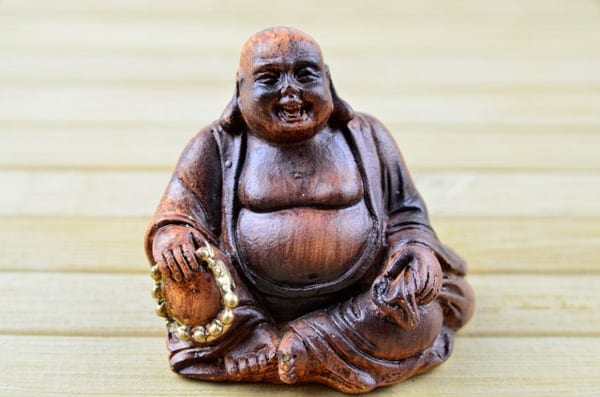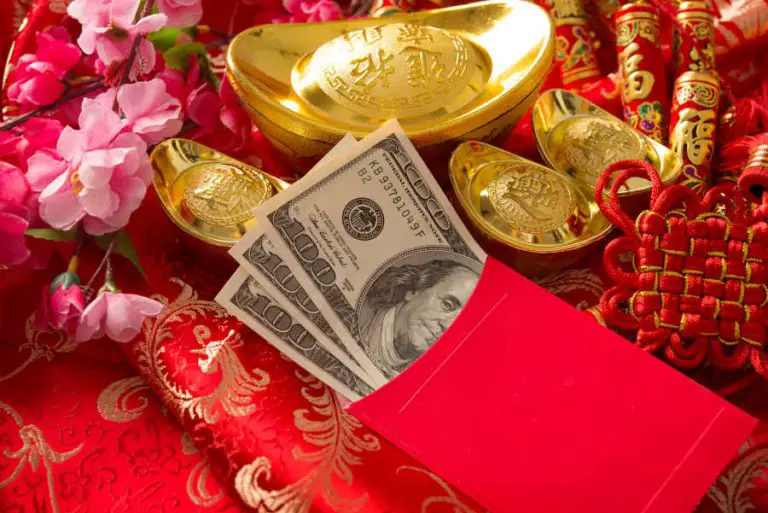In Feng Shui, the Laughing Buddha is among one of the most popular and commonly used charms, often used in many different Feng Shui applications to bring prosperity, good fortune, happiness, good health, and monetary success.
A unique thing about the Laughing Buddha is that it is one of the very few Feng Shui cures that can benefit all Feng Shui Bagua areas, making it very universal.
Yet, what actually is the meaning of the Laughing Buddha? Why is the Buddha laughing? Isn’t the divine Buddha supposed to be tranquil and serene?
Here, we will discuss all you need to know about the Laughing Buddha, from its meaning, history, different types of Laughing Buddha, and ultimately, how to use this Feng Shui cure to improve your fortune.
Without further ado, let us begin.
The Origin of the Laughing Buddha
While there are several different versions of how the Laughing Buddha figure emerged, the most famous one originated from Chinese folktales from the 10th century CE.
The story centered on a Ch’an (today also known as Zen) monk named Qieci or Ch’i-t’zu. The setting of the story is a place called Fenghua, which is in modern China in the province of Zhejiang.
Ch’i-t’zu was known as an eccentric monk but was loved by many people around Fenghua. Ch’i-t’zu often performed small miracles like predicting the weather, so many people often flocked around him. According to history, Ch’i-t’zu was a real person that lived around 907=923 CE.
Ch’i-t’zu was believed as an incarnation of the Gautama Buddha (Shakyamuni), and he came to be called Budai, or Pu-Tai, which can be roughly translated to “hempen sack”. This is because according to stories, Ch’i-t’zu always carries a sack full of presents, like sweets for children, food for the poor, and other things.
This is how Budai then is known as the symbol of generosity, wealth, and especially, happiness, and how the Laughing Buddha becomes the protector of the poor, weak, and children.
Today we can easily find a statue of Budai, the Laughing Buddha near the entrance of most Chinese Buddhist temples. The popular tradition is to rub the Laughing Buddha statue’s belly for good luck, albeit this is not genuine Buddhist teaching (just a folk tradition).
It is worth noting that the Laughing Buddha is not to be confused with the “true” Buddha, Siddharta Gauthama, or the Shakyamuni Buddha, but is instead believed to be his reincarnation, with the title Maitreya Buddha.
Take a look at these “Laughing Buddha” designs – Aff.link

How Many Types of Laughing Buddha Are There?
There are actually countless different variations of Laughing Buddha statues and charms available all over the world. However, here are some of the most popular ones, representing different wishes:
Laughing Buddha With Children
One of the most common Laughing Buddha charms or statues is Laughing Buddha playing or sitting with five children (typically five, but can be more or fewer). This type of Laughing Buddha is a common Feng Shui cure for people who want to be blessed with children soon.
However, it also symbolizes good fortune and prosperity and can act as a general Feng Shui cure for positive energies and good fortune.
Laughing Buddha With a Fan
This type symbolizes happiness, and it is believed that the waving of the fan symbolizes the banishment of troubles, protecting the owner from bad luck.
Might also carry a bottle gourd together with the fan, which can help those who are going through health issues. Apart from being believed to bring good health, Laughing Buddha with a fan and gourd is also believed to bring good luck in life.
Related reading: “Chinese Good Luck Charms To Bring Good Fortune” –Opens in new tab
Laughing Buddha With a Bowl
The bowl here symbolizes the life of a monk: renouncing material possession to receive enlightenment. Typically the Buddha is often depicted in a meditating position. Those currently facing anxiety, stress, nightmares, and other mental issues can benefit from keeping this type of Laughing Buddha in their house or workplace to improve their mental state.
Laughing Buddha With a Bag
The Budai is often depicted carrying a sack or a bag. The sack symbolizes a traveler, and it is believed that the sack collects people’s sadness and bad luck. The Laughing Buddha, then, takes away and collects people’s bad energies and put them in this bag.
The Laughing Buddha might also carry a bag of treasure, and is believed to bring good monetary fortune to the owner. Those going through financial issues can benefit from keeping this type of Laughing Buddha in their house or workplace to fight their financial problems.
Laughing Buddha With Beads
Depicting a meditating/praying monk, the beads symbolize wisdom. Believed to bring protection to the owner. Alternatively, the Laughing Buddha might be depicted as carrying a wealth ball, which is believed to bring wealth and prosperity.
Want to learn more about Feng Shui? Take a look at these Courses and Books – Aff.link
Laughing Buddha With Both Hands Raised
This type of Laughing Buddha is believed to help us progress in career/business and achieve success. You can place this form of Buddha in the office or on your working desk at home. The Buddha might also carry two balls, one on each hand, which represent wealth luck, and prosperity.
Also, the Laughing Buddha might be depicted in various different other postures:
- Sitting: symbolizing tranquility and balance of thoughts also symbolizes the Laughing Buddha’s love and protection for the poor and children. Buddha sitting on a large gold nugget and ready to give a smaller Chinese money/nugget is a symbol of prosperity.
- Standing: symbolizes happiness and riches
- Hand on head: symbolizes enjoyment, happiness, and good fortune
- Upright position: typically also carrying a gold nugget with his hands, symbolizes riches and prosperity
- Bag on the right shoulder: together with a fan on the left shoulder, symbolizes protection during long journeys.
Related reading: “A Concise Timetable of Feng Shui History“ –Opens in new tab

Placements and Directions of Laughing Buddha At Home
When placing a Laughing Buddha charm in the house as a Feng Shui cure, a common tradition is to rub the Buddha’s tummy every day. This practice is believed to make the Laughing Buddha happy so he will grant your wishes in return.
Make sure to rub his tummy with a positive, happy attitude, and remember that the Laughing Buddha loves joy and happiness from people around him.
It’s best to get a relatively big Laughing Buddha, at least 2 to 3 feet in height so you can actually rub the stomach.
With that being said, here are some common placements and directions for the Laughing Buddha cure:
The Homeowner’s Sheng Chi Direction
Each different individual has their own Sheng Chi (literally translated to “good qi/energy”). Placing Laughing Buddha in this specific Sheng Chi direction will improve the owner’s fortune in wealth, success in career, and overall prosperity in life.
🍀 Our “Feng Shui Master” app is your trusted companion, offering a useful guide to implementing Feng Shui principles. Try it now!
The East Direction
The eastern side of the house is believed to be the family’s luck spot. Placing the Budai in this direction is believed to bring happiness and family harmony. Remember that the Laughing Buddha isn’t solely about wealth and fortune, but can also help with your mental state and protect the whole family.
For example, placing the Laughing Buddha in this area can bring stress relief even when your family is fighting with each other. Related reading: How to Use Feng Shui Principles to Make a Stress-free Home
Your Work Desk
If you have a working area at home, you can place the Laughing Buddha on your desk, which is believed to help you in finding career opportunities and improve your career luck.
Students can also get the same effect when placing the Budai on their study table, believed to improve concentration to optimize their academic performance. The Laughing Buddha in our working area is also believed to prevent disputes and arguments with the people we work with.
Children’s Room
Since the Laughing Buddha is considered a protector of children, you can place a small statue of the Budai in your children’s room, facing the door.
Outdoor
You can place the Laughing Buddha in your garden area or on your balcony. If you have a water fountain or pool, it’s best to place the Laughing Buddha near this water body. Placing the Budai near a flowering plant can also help improve your spiritual growth and happiness.
Take a look at these “Laughing Buddha” designs – Aff.link
Things To Avoid When Placing The Laughing Buddha
- Don’t Keep Laughing Buddha Below Eye Level
A very important consideration is not to place the Laughing Buddha charm (any Buddha ornaments, in fact) below eye level. Looking down at the Buddha is considered disrespectful.
- Don’t Place It In The Bathroom
The general rule is to avoid placing the Laughing Buddha in any room with “negative” energy such as your bathroom, toilet, storerooms, kitchen, and laundry rooms. It shouldn’t be placed on the floor by all means. Also, avoid placing it on your TV set.
- Face The Main Door
What’s considered the best practice is to place the Laughing Buddha at least 30 inches off the ground, facing the main door.
If it’s simply not possible to place the Laughing Buddha facing the main door, place it on a side or a table facing the main door.
- Treat It With Respect
Remember that the Laughing Buddha is a revered symbol in both Feng Shui and Buddhism, so always treat it with respect. Clean it as often as you can, and don’t place it in a room that is often dirty.
Stay in Touch
 Join our newsletter by using the forms on this website or click here!
Join our newsletter by using the forms on this website or click here! Follow us on Google News
Follow us on Google News Follow us on Facebook
Follow us on Facebook
Feature Image from Depositphotos





